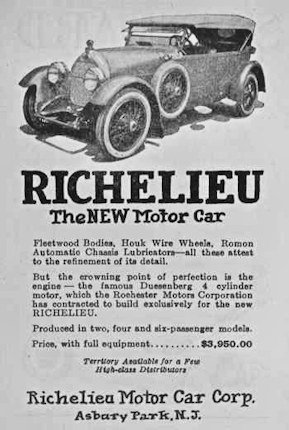Richelieu Motor Car Company

The Richelieu Motor Car Company is a former American car manufacturer from the 1920s and built luxury cars.
History
The company was founded by former employees of the Duesenberg Motors Corporation (DMC), which had built in the First World War in New York predominantly aircraft engines. As a result, the rights arrived at the large volume Duesenberg- four-cylinder engine to the Rochester Motors Company, Inc. Richelieu was one of the customers who used these engines called Rochester-Duesenberg.
President of the Richelieu Motor Car Company was former DMC Sales Manager NG Rost, Vice President William Beekman, Fred Duesenberg's former assistant. The other board was composed of bankers and investors. It was founded in October 1921 and the launch of the only model T-85 at the New York Motor Show in late November of the same year. It seems that one of the investors Newton Van Zandt, previously with little success and often dubious methods the ReVere Motor Corporation had led one of the competitors who also used Duesenberg engines. For a short time, he was then employed at Duesenberg. It is not excluded that Van Zandt brought a ReVere to Asbury Park and this served without ReVeres knowledge as a blueprint for the Richelieu.
The T-85 was initially available only as a four-door touring with a body by Fleetwood. The design was sporty European. The wheelbase was 3327 mm (131 inches). With the nickel-plated, rounded radiator surround Richelieu reminiscent of large Fiat models. He had narrow-cut fenders and no continuous footboard. Instead, there was a nickel-plated tread to each of the four doors. Laced wheels Large, drum-shaped headlights and a horizontally split windshield completed the equipment.
The 85 bhp (63.4 kW) provided more than enough power in their time; the race version from which he was derived had 100 bhp (74.6 kW). However, the required price of US $ 3950, - for the four-seater was considerable: the Richelieu was a luxury car and more expensive than the established competition.
For 1923 there were more body styles, all of them produced by Fleetwood. The Touring was a two-seater roadster, each US $ 4200, and new was a seven -seater sedan to US $ 6000. Richelieu was not strong enough to survive the economic crisis of the early 1920s. In February 1923, the company had to disclose its numbers. The debts of US $ 46,851, - were compared to values of US $ 272. The management tried to establish a successor company called Advanced Motors and announced the construction of a light sports car called Barbarino. As a result, there was a court dispute with the designer Salvatore Barbarino and the Barbarino Motor Car Company. Advanced Motors was prohibited until the beginning of 1923 to issue more shares.
The T-85 was equipped with wheels of dimension 32 × 4½ inches. Power transmission a four-speed gearbox with directly found top gear; in sporty versions of the fourth gear was designed as overdrive. The rear axle was optionally stocked 3.0: 1 or 3.5: special spare wheel covers and a special version of the soft top. Nickel-plated steps and Houk spoke wheels were standard features. The position lights were moved to another location. Initially, the Richelieu factory was only available as a four-door touring. In 1923, a roadster was added. Some vehicles were later produced bodies of local coachbuilders such as the United Body Company in Rahway (New Jersey), which the company may had for a short time. As one of the suppliers of Locomobile bodyshells and custom-made for various European brands (Mercedes, Renault, Rolls-Royce), United Body had experience in the luxury car market. The bodies produced in small batches were also hand-made products of high quality. At that time, they usually consisted of a wood frame with sheet metal planking. The T-85 was initially available only as a four-door touring with a body by Fleetwood, a roadster and a sedan followed in 1923.
